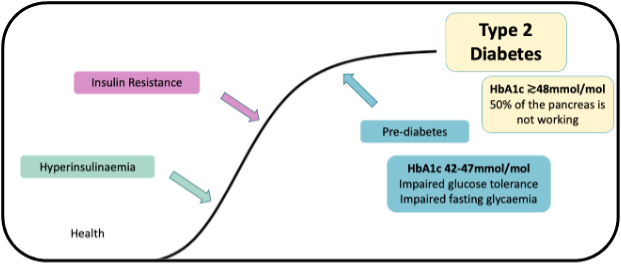
09 Jan How to Reverse Type 2 Diabetes: Understanding Prediabetes and Early Prevention
Prediabetes is a critical warning sign on the path to type 2 diabetes. Identifying and addressing it early can help you take control and even reverse type 2 diabetes before it develops.
What is Prediabetes and How is it Measured?
Prediabetes is the stage before type 2 diabetes, where blood sugar levels are higher than normal but not yet in the diabetic range. Doctors measure this using a blood test called HbA1c, which shows your average blood sugar over the past three months.
For prediabetes, HbA1c levels are typically between 42–47 mmol/mol. Levels of 48 mmol/mol or higher indicate type 2 diabetes. This is different from the numbers you see on a home glucose monitor or finger-prick test.
Who is at Risk of Developing Type 2 Diabetes?
Many people may be at risk without knowing it. Diabetes UK has a risk calculator that anyone can use to check their risk. Common risk factors include:
- Weight: Higher body weight increases risk — check your BMI here.
- Ethnicity: South Asian, Chinese, African-Caribbean, and Black African populations have a higher risk, even at younger ages and lower weights.
- Visceral Fat: Fat around your organs is dangerous. Measure your waist: over 80cm for women or 94cm for men indicates higher risk.
- Gender: Men have slightly higher risk than women.
- Age: Risk increases after 40 for Caucasians, and after 25 for higher-risk ethnic groups.
- Family History: First-degree relatives with type 2 diabetes increase your risk 2–6x.
- High Blood Pressure: Even if treated, it contributes to higher risk.
Why Does Prediabetes Matter for Reversing Type 2 Diabetes?
Knowing you have prediabetes is crucial because prevention is better than cure. Type 2 diabetes doesn’t start suddenly — research shows changes can be detected up to 20 years before symptoms appear, even before blood sugar reaches the prediabetes range.
Early detection allows you to implement lifestyle changes that can reverse or delay type 2 diabetes, including diet, exercise, and weight management.

What Are the Symptoms of Prediabetes?
Most people with prediabetes experience no symptoms. Some may feel more tired than usual or notice mild versions of excessive thirst or frequent urination seen in diabetes. The best way to know if you might have prediabetes is to check your risk and get a blood test from your GP if necessary.
How Can Lifestyle Changes Help Reverse Type 2 Diabetes?
The great news is that type 2 diabetes is largely preventable with lifestyle changes. Focus on:
- Improving diet quality with whole, minimally processed foods, prioritizing vegetables, lean protein, healthy fats, and fibre
- Regular physical activity: aim for 150 minutes per week of moderate exercise, plus resistance training 2–3 times per week
- Weight management and reducing visceral fat — even 5–10% weight loss has a significant impact
- Monitoring blood sugar and taking early action with your GP
- Sleep and stress management: poor sleep and chronic stress worsen insulin resistance
For a comprehensive guide on how diet, lifestyle, and behavioural changes can help reverse type 2 diabetes, check out Dr Nerys Frater’s resources: Watch the three-part breakthrough video and download the free blood sugar guide PDF.
When Should I Start Making Changes to Prevent Type 2 Diabetes?
Don’t wait until a diagnosis. Early intervention through diet, exercise, and lifestyle adjustments can significantly reduce your risk and even reverse type 2 diabetes before it develops. Start now, track your progress, and celebrate small victories along the way.
